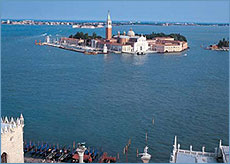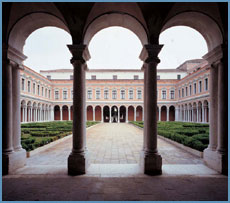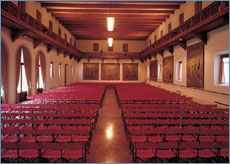| The 1st World Conference on the Future
of Science will be held on September 21st-23rd 2005,
in Venice, Italy, at the Fondazione Giorgio
Cini on the Isle of San Giorgio Maggiore.
The Isle of San Giorgio lies in the St.Mark’s Basin, facing
the Dodges’ Palace (Palazzo Ducale, Opening Ceremony), the
main city’s monument.
The Giorgio Cini Foundation
This institution was founded by Vittorio Cini to commemorate his
son Giorgio, who had tragically died in an air crash on 31 August
1949.
 Created on 20 April 1951, the Foundation was granted official
juridical status by a degree of the President of the Republic on
July 12th the same year. The state-owned island of San Giorgio
Maggiore was made available to the Foundation, provided
the monumental part was properly restored and became the centre
of the Foundation’s activities.
Created on 20 April 1951, the Foundation was granted official
juridical status by a degree of the President of the Republic on
July 12th the same year. The state-owned island of San Giorgio
Maggiore was made available to the Foundation, provided
the monumental part was properly restored and became the centre
of the Foundation’s activities.
In little over a year, with his typical spirit and energy, Vittorio
Cini transformed an irreparable loss into an endeavour perpetuating
the memory of his son Giorgio. Vittorio made over most of his possessions
to a project that was to mark the history of Italian culture and
have echoes and repercussions worldwide.
While restoration work was underway, the Foundation had to tackle
two long-standing socio-economic problems, which in the post-war
period were particularly acute and deeply felt. The first problem
was that of young people suffering from family difficulties and
social hardship with no outlets in traditional forms of education
and schooling or structures able to help them to prepare and obtain
qualifications for life in the new society. The other problem concerned
the decline in rigorous high-standard research work, since the universes
didn't even have suitable means to educate their students, the art
colleges were stagnant, and there were almost no institutes for
research or specialised higher education.
The Foundation met the first challenge by creating two social centres:
A Naval Training Centre and an Arts and Crafts Centre. They played
a pioneering role and had a nationwide catalysing effect (they even
influenced the reform and drafting of new curricula for professional
state education).
 To
tackle the second problem, the Foundation created the Centre of
Culture and Civilisation. Aimed at contributing to scientific and
cultural progress, this even wider-ranging initiative embraced the
School of San Giorgio for the Study of Venetian Civilisation, which
was divided into three institutes for advanced research. To
tackle the second problem, the Foundation created the Centre of
Culture and Civilisation. Aimed at contributing to scientific and
cultural progress, this even wider-ranging initiative embraced the
School of San Giorgio for the Study of Venetian Civilisation, which
was divided into three institutes for advanced research.
The Centre of Culture and Civilisation set out to promote and encourage
high-standard events by organising a continuous series of international
congresses and conferences to explore current artistic, scientific,
social, cultural and economic issues as well as staging various
other kinds of events: exhibitions, theatre, opera, and concerts.
Today there are eight institutes and they have mainly lost their
specifically Venetian character to become thoroughgoing international
research centres.
The Cini Foundation Research Institutes
Inspired by Anglo-Saxon type institutes for advance studies, the
Foundation Institutes promote exhibitions, conferences, workshops,
and courses. They also publish books and periodicals, and offer
hospitality to researchers and scholars who make use of the invaluable
archive collections.
The Institute of Art History
Created in 1954, the Institute of Art History has three main kinds
of activities: the organisation and patronage of research and publications,
especially applied to the Veneto area; exhibitions; and lectures,
workshops and conferences.
The Institute also boasts a photographic library, a unique research
facility now housing over 730,000 photographs, mostly dedicated
to the art of the Veneto. This huge collection also contains 40,000
photographs in the Regional Photographic Archives, placed in the
Foundation’s care in 1981 by the Veneto Region.
The Institute’s publishing activities include not only exhibition
catalogues and art collections, essays and monographs dedicated
to artists, collections or genres, but also two reviews: Arte Veneta
and Saggi e Memorie di Storia dell’Arte, which after decades
of activity have become vital reference works for scholars worldwide.
Lastly, mention must be made of the very rich Institute library,
consisting of over 110,000 books kept in the building designed in
1641 by Baldassare Longhena. In addition to collections of modern
texts, the library also has a unique corpus of incunabula and illustrated
Renaissance works, consisting of 1,956 books (including 401 printed
in Venice). The Institute is also responsible for studying and preserving
the Cini Foundation art collections.
The Institute for the History of the Venetian
State and Society
This Institute was created in 1955 with the objective of promoting
the study of the Venetian state and society. Over the years, especially
thanks to its microfilm library - a physically vast documentary
resource, also including original documents (a whole series of diplomatic
dispatches and correspondence) - the Institute has become
a reference facility for all scholars wishing to consult complementary
sources to the Venetian libraries (especially the collections in
Venetian State Archives) or originals which, although Venetian,
have ended up in foreign archives and libraries and therefore cannot
be consulted in Venice.
The Institute's research activities include a host of conferences
and workshops, as well as publications such as Studi veneziani,
a prestigious annual review.
The Institute for Literature, Theatre and
Opera
Created in 1957, as its name suggests this Institute is very active
in the research fields of literature, theatre and opera.
 An
essential part of the literature section is the study of Venetian,
the local dialect, once the principal language of the people, administration
and literature. In this field the Veneto Lexical Archives is the
most important tool for research and cataloguing. Its over 400,000
files document the spread of Venetian on the mainland and throughout
the Mediterranean. The Mediterranean is also the subject of another
major Institute project, the “Mediterranean Linguistic Atlas”,
conceived in 1958 to highlight the linguistic links underlying relations
between the peoples and civilisations in the Mediterranean basin.
The Institute also houses several other archives, consisting of
the correspondence of leading literary and theatrical figures (Eleonora
Duse, Gabriele D’Annunzio, Giovanni Pascoli, and Diego Valeri). An
essential part of the literature section is the study of Venetian,
the local dialect, once the principal language of the people, administration
and literature. In this field the Veneto Lexical Archives is the
most important tool for research and cataloguing. Its over 400,000
files document the spread of Venetian on the mainland and throughout
the Mediterranean. The Mediterranean is also the subject of another
major Institute project, the “Mediterranean Linguistic Atlas”,
conceived in 1958 to highlight the linguistic links underlying relations
between the peoples and civilisations in the Mediterranean basin.
The Institute also houses several other archives, consisting of
the correspondence of leading literary and theatrical figures (Eleonora
Duse, Gabriele D’Annunzio, Giovanni Pascoli, and Diego Valeri).
The theatre section contains various collections and archives, the
principal ones being the Ulderico Rolandi Archives, the largest
collection of librettos in Europe, and the Theatre Iconography Archives,
consisting of over 16,000 photographs of stage sets and theatre
architecture.
The Venice and the East Institute
This Institute was founded in 1958 with the main aim of promoting
studies of the civilisations of India and the Far East. Over the
years the Institute has become a centre of constant dialogue between
East and West, and their respective peoples, civilisations and religions.
Thanks to its very rich library, workshops, and conferences, as
well as the publication of a series of books (Orientalia Venetiana),
the Institute is visited by scholars from all over the world. One
particularly important collection is the Alain Daniélou Indological
Archives, containing not only books and periodicals but also hundreds
of thousands of files on the Indian tradition, now being catalogued
digitally.
The Italian Antonio Vivaldi Institute
Founded in 1947 by Antonio Fanna, the Institute joined the foundation
in 1978 to mark the 300th anniversary of the composer's birth.
The Institute's main activities are the critical edition of the
whole Vivaldi corpus (around 800 instrumental, vocal and operatic
works). Each composition is accompanied by historical notes, suggestions
for performers and a critical apparatus in English and Italian.
The Institute has also recently begun publishing Vivaldi’s
music (both manuscript and printed) in facsimile form.
Lastly, the Institute also publishes studies in a series called
Quaderni Vivaldiani and the annual review Studi Vivaldiani.
The Institute of Music
The Institute of Music was created in 1985 and boasts important
archives and collections: polyphonic vocal sacred and profane Veneto
music from the 16th and 17th centuries; a unique collection of archives
of various 20th-century Italian composers and musicians (Gian Franceso
Malipiero, Alfredo Casella, Camillo Togni, Nino Rota, Luigi Cortese,
Olga Rudge and Gino Gorini), with original documents (correspondence,
writings, autograph compositions and drafts); the Arrigo Boito Collection
consisting of music manuscripts, correspondence and original autograph
librettos; and the Aurel Milloss archives, including the famous
choreographer’s music library.
The archives are a very useful facility for research, study and
cultural projects, and have given rise to the publication of essays,
critical editions, catalogues and performances (especially of rare
and previously unperformed works).
The Institute also promotes research projects for 16th and 17th
century sacred music, Venetian farce and the music for Goldoni’s
theatre. The Institute continuously collaborates with the Luigi
Nono Archives, and organises annual study meetings. Lastly, the
Institute also owns the National Edition of the Works by Andrea
Gabrielli.
The Intercultural Institute of Comparative
Music Studies
This institute was created in 1978 by Alan Alain Daniélou
in conjunction with the International Institute for Comparative
Music Studies and Documentation, Berlin, in order to promote and
spread knowledge about the highest forms of music in non-Western
civilisations. The Institute has always focused on introducing leading
performers of traditional music from Oriental and African countries
to Western audiences.
Through its Intercultural School of Music, the Institute also organises
education activities based on theoretical and practical teaching
of the great world music traditions.
The Venice and Europe Institute
Created in 2002, the Institute highlights the Foundation’s
permanent commitment to improve dialogue between cultures, religions
and traditions in Europe.
The Institute's activities continue a tradition of research into
the Greek-Byzantine world and countries in Eastern Europe, combined
with a focus on the Mediterranean dimension in Europe, the themes
of dialogue and relations, especially with the Near East and Islam,
and the key centres involved in forging a new European culture.
To this end, it has organised - and organises - seminars
and conferences as well as research projects and study workshops.
Giorgio Cini Foudation Website: http://www.cini.it
|
 |




